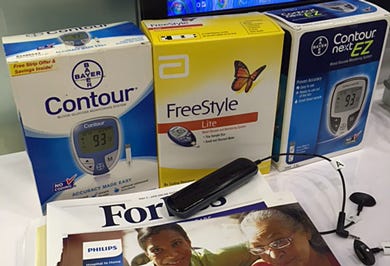May 18, 2016
Apple, Google, Philips, Withings, and many more companies are taking the space by storm. Meanwhile, some traditional telecommunications companies could be falling behind.
|
Offerings Philips touted at ATA included a dongle that can connect to glucose meters and upload data to an eCareCompanion tablet that also uploads the information via the web to an eCareCoordinator that can be monitored by their health provider. (Image by senior editor Chris Newmarker) |
Nancy Crotti
The global telemedicine market, estimated at $14.4 billion in 2015, is projected to hit $34 billion by 2020, according to Mordor Intelligence. So where are the big companies that had planned to take the fledgling industry by storm just a few years ago?
Apple and Google have been grabbing the telehealth headlines while startups like Amwell and Doctor on Demand drew lots of interest at this week's American Telemedicine Association (ATA) conference in Minneapolis.
Other companies with a major presence at AT&T included Philips; Medtronic; Welch Allyn; and the French health and fitness device company Withings, which is being acquired by Nokia.
Check out this video of a Withings wireless blood pressure monitor, touted at the show, that easily syncs with an iOS or Android device, and can share data with a health provider:
AT&T had a booth, but Verizon was nowhere to be found. Neither has fulfilled its early promises for the industry, Bloomberg reports.
ATA defines telemedicine as "the use of medical information exchanged from one site to another via electronic communications to improve a patient's clinical health status." Telemedicine, according to ATA, includes applications and services using two-way video, email, smart phones, wireless tools and other forms of telecommunications technology.
Google's cofounders once downplayed their interest in turning the tech giant into a healthcare company. Could have fooled us. Google spun off a healthcare company called Verily last December, and has ventured into smart contact lenses and surgical robotics and surgical laser ablation.
Medtronic's not afraid of big, bad Google, according to CEO Omar Ishrak. But should it be? And what about Apple? A recently revealed patent application showed that Apple plans to make a medical monitor that can sound an alert based on irregularities in a user's temperature, heart rate, oxygen level, or blood pressure. In March, Apple announced it would launch another frameworkto help app developers enable patients to manage their medical conditions.
Data carriers Verizon and AT&T in 2009 started promising big telemedicine advances that never came to pass. They've profited from handling health data connections and electronic medical records for hospitals, but "haven't done a good job of moving into the hospital setting and investing the time and money to live in the footsteps of the providers," Lee Schwamm, medical director of telehealth at Massachusetts General Hospital, told Bloomberg. "It's always been a side business to them."
That still promises to be a steadily growing business as health systems adopt telemedicine strategies to connect with an aging population.
Comparing AT&T and Verizon, AT&T at least seems to be accomplishing some things. In 2009, AT&T developed smart slippers that could wirelessly alert medical staff if a patient is stumbling or has fallen. Two years later, it introduced wirelessly connected pill bottle tops that can alert patients with blinking lights and ringing chimes to take their medicine. In 2014, the company hired mHealth Visionary Eric Topol, MD, to increase its visibility in the medical device industry.
In an effort to compete with smaller telemedicine companies, Verizon introduced its Virtual Visits telemedicine conferencing packages in 2014, only to shutter it less than a year later.
"If Verizon's stated intention was to be a leader in this field," Schwamm told Bloomberg, "then they have failed."
Qmed senior editor Chris Newmarker contributed to this story.
Learn more about cutting-edge medical devices at MD&M East, June 14-15, 2016 in New York City. |
Nancy Crotti is a contributor to Qmed.
Like what you're reading? Subscribe to our daily e-newsletter.
About the Author(s)
You May Also Like



